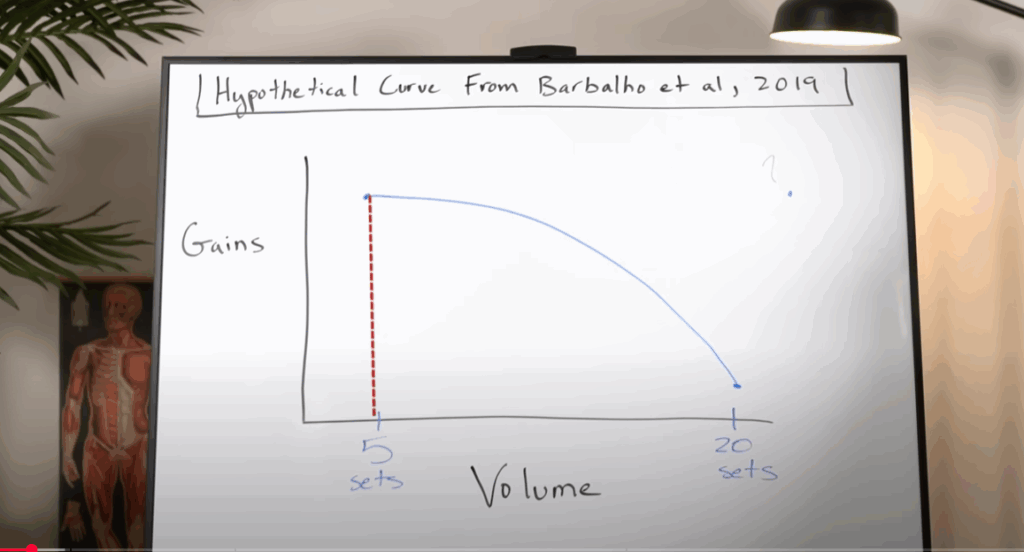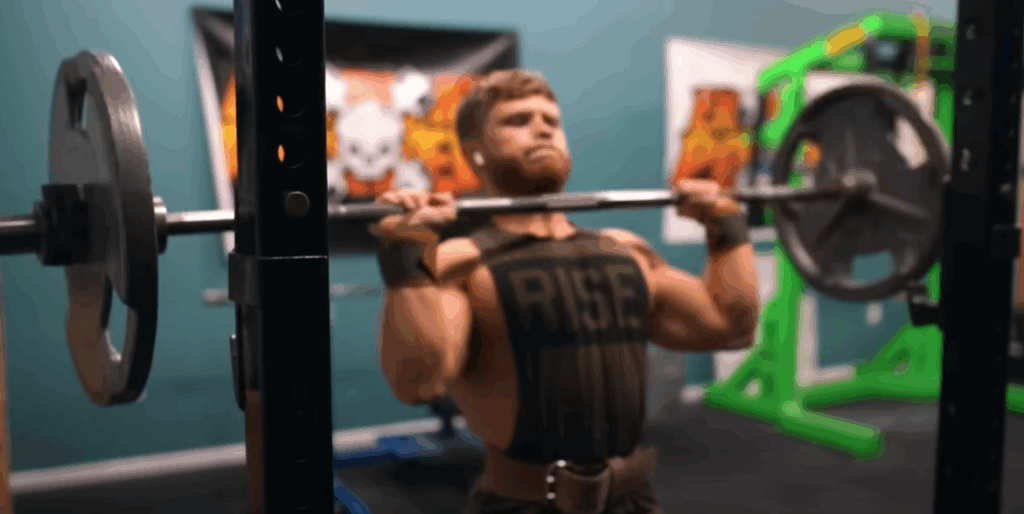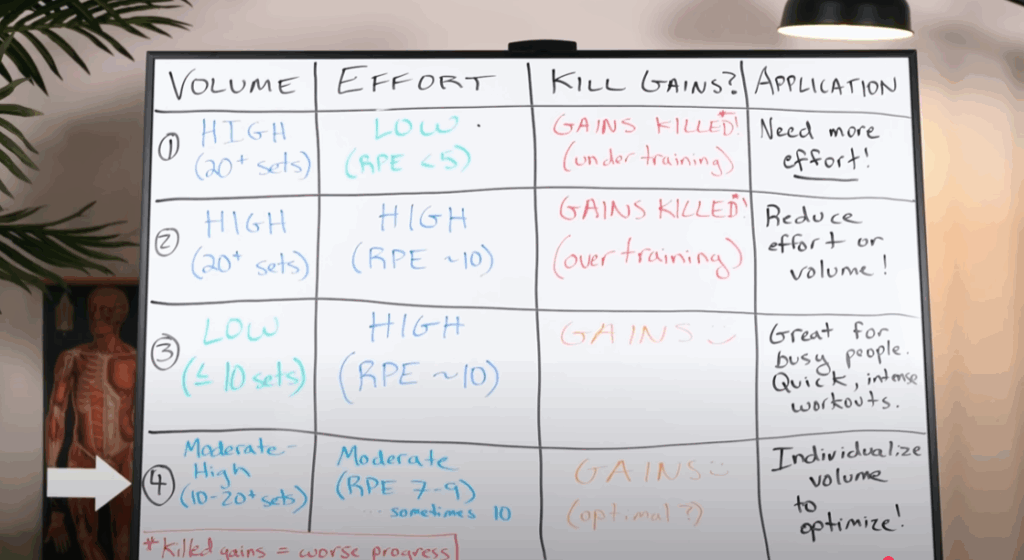Is Training Volume Killing Your Muscle Gains? A New Look at Volume, Effort, and Growth
In bodybuilding circles, the debate over training volume never seems to go away. Is more volume always better? Or can too much of it actually stall your progress—or worse, shrink your gains? Recent research suggests that there’s more to the story than just doing more sets. In fact, under certain conditions, excessive training volume may actually backfire, especially if it’s not paired with sufficient effort.
Let’s break down the science behind training volume, explore new findings, and uncover how to structure your workouts for optimal hypertrophy—without falling into the trap of junk volume.

What We Used to Believe About Volume
For years, the dominant idea in hypertrophy training has been that more sets lead to more muscle—up to a point. Meta-analyses, like the well-cited 2017 review that pooled data from 15 studies, showed a positive correlation between volume and muscle growth. In other words, doing more working sets per week (roughly 10–20 per muscle group) generally resulted in more gains.
But it was also understood that this benefit didn’t go on forever. After a certain threshold, the returns diminish. Push past this limit without managing recovery and intensity properly, and your gains may plateau—or even regress due to overtraining and excessive fatigue.
New Data: Can More Volume Actually Hurt Gains?
A recent study by Barbelo and colleagues has stirred the pot. In this trial, trained men were split into four groups based on weekly volume: 5, 10, 15, or 20 sets per muscle group. All participants followed the same exercises and split their training over just three days a week (e.g., push, pull, and legs). After six months, the surprising result was that the 5-set group saw the most muscle growth, while the 20-set group made the least progress, even losing some size in areas like the pecs.
At first glance, this appears to turn traditional volume principles on their head. But once you dig into the context, it starts to make more sense.
Not All Volume Is Equal: Understanding Context
Here’s what’s important to consider:
- Training Status Matters
While these subjects had several years of lifting experience, their performance levels suggested they were still relatively untrained. Less experienced lifters tend to respond better to lower volumes, since their bodies haven’t yet adapted to handle large workloads. - The Per-Session Volume Threshold
Perhaps more crucially, all 20 sets in the highest volume group were completed in a single workout per muscle group each week. That’s an intense, high-volume session, all concentrated on one muscle group at once—something that likely exceeded their recovery and adaptation capabilities.

The Per-Session Cap: Why Splitting Volume Matters
Emerging research points toward the concept of a per-session volume cap—a limit on how many sets your body can effectively use for growth in a single session. Once you go beyond this point, each additional set contributes less and less to hypertrophy, and eventually might just add unnecessary fatigue.
A rodent study cited in the MASS research review showed a plateau in muscle protein synthesis after around five sets in a single session. While we obviously can’t draw exact parallels to humans, it gives us a useful conceptual model: if you jam all your volume into one day, you’re not maximizing the value of each set.
By spreading your total volume over multiple weekly sessions—say, training chest twice a week instead of once—you’re likely to get better results with the same weekly effort.
So, Is Volume the Enemy?
Not exactly. Volume isn’t inherently bad—but too much volume performed without adequate intensity or recovery is a recipe for stagnation.
This brings us back to a key issue raised by Jeff Cavaliere: many lifters are relying on increasing volume as a substitute for hard work. They’re coasting through sets, leaving 5+ reps in reserve, and convincing themselves that more sets equals more growth. But without sufficient effort, this volume becomes “junk”—filler that taxes your body without stimulating adaptation.
Four Training Scenarios: Which Helps and Which Hurts?
Let’s break down four common volume/effort combinations and their likely outcomes:
- High Volume + Low Effort
This is the classic “junk volume” trap. You’re doing 20+ sets per week per muscle, but you’re stopping far from failure. This approach is inefficient and will likely kill your gains. - High Volume + High Effort
Now you’re going all-out on every set and doing a ton of volume. This might sound hardcore, but it’s a fast track to overtraining, burnout, and diminishing returns. The Barbelo study’s 20-set group showed exactly what can happen: reduced gains or even loss of muscle. - Low Volume + High Effort
This approach works surprisingly well, especially for busy lifters or those who can’t recover from high weekly workloads. If you’re pushing each set close to failure, fewer sets can still yield solid hypertrophy. It’s time-efficient and sustainable, though perhaps not optimal for advanced trainees. - Moderate Volume + Moderate-to-High Effort (Optimal Zone)
This is where most lifters should aim to train. Hitting each muscle group with 10–20 quality sets per week, with most sets taken 1–2 reps from failure, seems to be the sweet spot for growth. It balances volume and effort to avoid overtraining while ensuring enough stimulus for progress.

Key Takeaways: How to Apply This to Your Training
- Don’t chase volume for its own sake. More sets aren’t better if your effort is low or if you’re piling them all into one day.
- Distribute your volume throughout the week. Instead of 15 chest sets on Monday, split them across two or three sessions for better quality and recovery.
- Effort matters. Whether you’re doing five sets or twenty, training close to failure is critical to activate the muscle fibers responsible for growth.
- Individualize your plan. Beginners may thrive on less volume. Advanced athletes may need more. Adjust based on your experience, recovery, and results.
Final Thoughts
The conversation around volume is evolving. While high-volume routines have their place, blindly chasing more sets without matching intensity or distributing your workload can sabotage your progress.
By combining thoughtful volume planning with sufficient effort—and adjusting based on your training level—you can avoid the pitfalls of both overtraining and under-stimulation. Quality beats quantity every time.
If you want to keep learning, check out resources like Dr. Mike Israetel’s volume landmarks or scientific reviews like MASS. And remember: consistency, smart programming, and recovery always win in the long run.



